Advertisements
Advertisements
प्रश्न
3 mole of a gas at temperature 400 K expands isothermally from an initial volume of 4 litres to a final volume of 8 litres. Find the work done by the gas. (R = 8.31 J mol-1 K-1)
उत्तर
Given:
n = 3 mol, T = 400 K, Vi = 4 L, Vf = 8 L, R = 8.31 J mol-1 K-1
To find: Work done by gas (W)
Formula: `"W"_"isothermal"` = nRT In`"V"_"f"/"V"_"i"`
Calculation:
From formula (i),
W = 3 × 8.31 × 400 × In`(8/4)`
Now, ln x = 2.303 × log (x)
∴ In`(8/4)` = ln (2) = 2.303 log (2)
∴ W = 1200 × 8.31 × 2.303 × 0.3010
= antilog{log(1200) + log(8.31) + log (2.303) + log(0.3010)}
= antilog{3.0792 + 0.9196 + 0.3623 + (`overline1`.4786 )}
= antilog{3.8397}
= 6.913 × 103 J
= 6.913 kJ
Work done by the gas is 6.913 kJ.
APPEARS IN
संबंधित प्रश्न
A thermodynamic system is taken from an original state to an intermediate state by the linear process shown in Figure

Its volume is then reduced to the original value from E to F by an isobaric process. Calculate the total work done by the gas from D to E to F
An ideal gas is taken through an isothermal process. If it does 2000 J of work on its environment, how much heat is added to it?
Heating a gas in a constant volume container is an example of which process?
What is a thermodynamic process?
Draw a p-V diagram showing positive work with varying pressure.
State the assumptions made for thermodynamic processes.
Explain thermodynamics of the adiabatic process.
When you exercise in the morning, by considering your body as a thermodynamic system, which of the following is true?
Give the equation of state for an isothermal process.
Give an expression for work done in an isothermal process.
Draw the PV diagram for the adiabatic process.
Draw the PV diagram for the isobaric process.
Draw the PV diagram for the isochoric process.
What is meant by a reversible and irreversible processes?
Explain in detail an adiabatic process.
Derive the work done in an adiabatic process.
What are the limitations of the first law of thermodynamics?
An ideal gas is taken in a cyclic process as shown in the figure. Calculate
- work done by the gas
- work done on the gas
- Net work done in the process

A monoatomic gas of pressure p having volume V expands isothermally to a volume 2V and then adiabatically to a volume 16V. The final pressure of the gas is ____________.
`("ratio of specific heats" = 5/3)`
In an isothermal process, the volume of an ideal gas is halved. One can say that ____________.
An ideal gas is compressed to half its initial volume by means of several processes. Which of the process results in the maximum work done on the gas?
Ideal gas for which 'ϒ' = 1.5 is suddenly compressed to `1/4`th of its initial volume. The ratio of 4 the final pressure to the initial pressure is ______.
`(ϒ = "C"_"p"/"C"_"v")`
Consider P-V diagram for an ideal gas shown in figure.
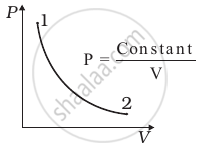
Out of the following diagrams (figure), which represents the T-P diagram?
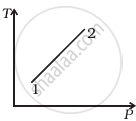 (i) |
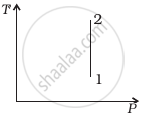 (ii) |
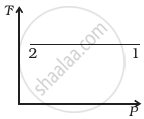 (iii) |
 (iv) |
In the figure shown here, the work done in the process ACBA is ______.
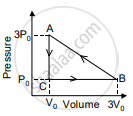
In a certain thermodynamical process, the pressure of a gas depends on its volume as kV3. The work done when the temperature changes from 100°C to 300°C will be ______ nR, where n denotes number of moles of a gas.
Explain how can a gas be expanded at constant temperature.
In a cyclic process, if ΔU = internal energy, W = work done, Q = Heat supplied then ______.
